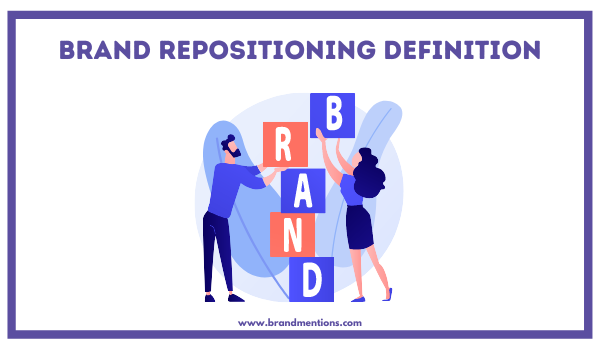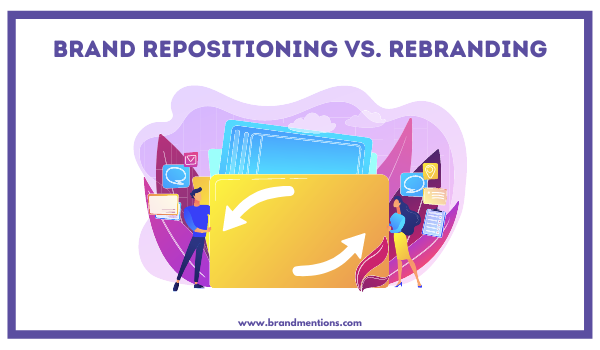Brand Repositioning
Brand repositioning is the process of adjusting some of the brand identity details to better appeal to its target audience. Brand repositioning refers to the process in which a company or organization alters its strategic direction to meet the desires and requirements of its intended audience. This process can include adjusting the brand's character or completely overhauling its commitment, such as changes in the marketing strategy, adding a new color to the logo, or adjusting the tone of voice.
The ultimate objective remains consistent: to enhance the brand's significance and attractiveness to consumers.

Contents
Why do Brand Repositioning?
There are many reasons why brands do brand repositioning. Some fall into the tangible repositioning category, while others are more subtle. Here are some of the reasons:
The target audience has changed - the markets are evolving; therefore, you need a more suitable market strategy, change the tone of voice or just undertake image repositioning for a fresher look.
Change in the products or services portfolio - if the portfolio expands out of alignment with the original brand position or a major change in the product range occurs, a repositioning strategy is the best way to go.
The market competitors offer better value - keeping up with your competitors is challenging. When increased competition offers better value and attracts more potential customers, consider repositioning your brand to avoid losing customers.
Sales are going down - many companies had repositioned themselves when their sales started to go down and when no other brand strategy or marketing changes delivered their expected results. This is an excellent way to start with a clean sleeve or create something more appealing to their audience.
The need for a newer image repositioning - how customers perceive your brand is essential to your brand status. Whether it is a new website design, a fresh brand design, or just adding a new color to your logo color scheme, your customer base will appreciate the change.

Repositioning
Repositioning generally refers to changing how a product, service, or company is perceived in the minds of its target audience. It can involve various marketing activities to alter customer perceptions and attitudes towards a brand, aiming to increase its competitiveness and appeal in the marketplace.
Here’s an example: a brand may choose to reposition a product by changing its pricing, marketing message, or packaging to appeal to a new target market or differentiate it from competitors. Similarly, a company may reposition itself by changing its brand image or mission statement to align with shifting consumer values or market trends.
Keep in mind that repositioning is a complex process and can be challenging at times, often requiring a significant amount of resources - an investment of time, money, and other resources to change customer perceptions and behaviors effectively. Nevertheless, if done successfully, repositioning can help companies stay relevant and competitive in a constantly evolving marketplace.
Brand Repositioning vs. Rebranding
While Brand Repositioning is about changing your brand’s position on the market in the eyes of your customers, rebranding is about completely changing its identity. This can involve changes to your brand’s name, logo, core product, business models, etc. Rebranding usually happens when a company is failing or has experienced a massive decrease in its reputation score.
Here are the main differences between rebranding and repositioning:
Rebranding:
- Refers to changing the brand's name, visual identity, or brand messaging.
- The goal of rebranding is to create a new brand image or perception in the minds of customers and stakeholders.
- Rebranding can be done for various reasons, such as keeping up with changing customer preferences, differentiating the brand from competitors, or reflecting a shift in the company's values or mission.
Repositioning:
- Refers to changing the brand's positioning in the marketplace or customers' minds.
- The goal of repositioning is to change the way customers perceive the brand and its products or services.
- Repositioning can be done by changing the brand's target audience, value proposition, marketing messages, or pricing strategy.
- Repositioning efforts are often made to address market or competition changes, take advantage of new growth opportunities, or overcome negative perceptions of the brand.
In summary, rebranding involves changing the brand's name, visual identity, or messaging, while repositioning consists in changing the brand's positioning in the marketplace or in customers' minds. Both can be effective strategies for improving a brand's image or market share, but they require different approaches and considerations.

Examples of Brand Repositioning
Brand repositioning strategy aims to change how a company's brand is perceived in the marketplace. It involves a range of activities, from analyzing the current market to implementing changes in web design, graphic design, color palette, and other elements of the brand. Brand repositioning can be done for a variety of reasons, such as to keep up with changing market trends or to differentiate a company from its competitors.
One example of brand repositioning is waste management company Waste Management's rebranding campaign in 2019. The company updated its logo and color palette to convey a more modern, environmentally conscious image. The rebranding helped the company improve its brand equity and appeal to younger, more environmentally aware customers.
Another example is teaching English company Rosetta Stone's shift from traditional outbound marketing to inbound marketing. By creating valuable content and guest posts on its blog, Rosetta Stone established itself as a thought leader in the language learning industry, which increased its brand monitoring and reputation management efforts.
Successful brand repositioning requires a thorough analysis of the current market and the company's brand in the marketplace. This includes evaluating the company's business ethics and reputation management efforts and examining its data science and visual arts assets. Marketing automation and search engine optimization can also play a crucial role in the repositioning process.
However, it is important to remember that brand repositioning takes time to implement and should be done carefully. Companies should consider their brand equity and make changes that are consistent with their overall mission and values. By repositioning successfully, companies can improve their competitiveness and appeal in the marketplace.
Here are some other interesting examples of companies that have repositioned their brand over the years:
Gucci - the brand repositioned itself when it realized that its audience was aging. In the era of digital marketing, Gucci realized it needed to appeal to a younger audience to keep up the pace. They polished their logo and transformed their fashion style from glossy to quirky, maintaining a bold brand signature. Gucci appealed to young social media users, quickly becoming a lifestyle brand with a successful brand repositioning story.
Old Spice - managed to reposition themselves from an old, dying brand to a fresh, seducing scent. With their “anything is possible when your man smells like Old Spice and not a lady (I’m on a horse)” viral video and six months of carefully planned social media marketing, the old deodorant brand revived itself with a fresh new identity, without changing its product or logo.
Taco Bell - the fast-food chain went from being seen as a cheap Mexican brand to a young, urban, fun brand. Their rebranding strategy needed more than a marketing campaign. From redesigning its restaurant's interior look to adding more products to its menu and subtly refreshing its logo, Taco Bell managed to attract a whole new target market and repositioned its entire brand identity without the need for its rebranding.
How do you know if your brand needs repositioning? Conduct a brand audit to understand how your brand is positioned in the market, find out how customers perceive your brand, and discover your strengths and weaknesses compared to your competition.